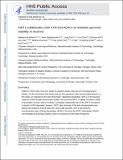SIRT1 collaborates with ATM and HDAC1 to maintain genomic stability in neurons
Author(s)
Dobbin, Matthew M.; Madabhushi, Ram; Pan, Ling; Chen, Yue; Kim, Dohoon; Gao, Jun; Ahanonu, Biafra; Pao, Ping-Chieh; Qiu, Yi; Zhao, Yingming; Tsai, Li-Huei; ... Show more Show less
DownloadTsai_SIRT1 collaborates.pdf (1.773Mb)
PUBLISHER_POLICY
Publisher Policy
Article is made available in accordance with the publisher's policy and may be subject to US copyright law. Please refer to the publisher's site for terms of use.
Terms of use
Metadata
Show full item recordAbstract
Defects in DNA repair have been linked to cognitive decline with age and neurodegenerative disease, yet the mechanisms that protect neurons from genotoxic stress remain largely obscure. We sought to characterize the roles of the NAD[superscript +]-dependent deacetylase SIRT1 in the neuronal response to DNA double-strand breaks (DSBs). We found that SIRT1 was rapidly recruited to DSBs in postmitotic neurons, where it showed a synergistic relationship with ataxia telangiectasia mutated (ATM). SIRT1 recruitment to breaks was ATM dependent; however, SIRT1 also stimulated ATM autophosphorylation and activity and stabilized ATM at DSB sites. After DSB induction, SIRT1 also bound the neuroprotective class I histone deacetylase HDAC1. We found that SIRT1 deacetylated HDAC1 and stimulated its enzymatic activity, which was necessary for DSB repair through the nonhomologous end-joining pathway. HDAC1 mutations that mimic a constitutively acetylated state rendered neurons more susceptible to DNA damage, whereas pharmacological SIRT1 activators that promoted HDAC1 deacetylation also reduced DNA damage in two mouse models of neurodegeneration. We propose that SIRT1 is an apical transducer of the DSB response and that SIRT1 activation offers an important therapeutic avenue in neurodegeneration.
Date issued
2013-07Department
Massachusetts Institute of Technology. Department of Brain and Cognitive Sciences; Picower Institute for Learning and MemoryJournal
Nature Neuroscience
Publisher
Nature Publishing Group
Citation
Dobbin, Matthew M, Ram Madabhushi, Ling Pan, Yue Chen, Dohoon Kim, Jun Gao, Biafra Ahanonu, et al. “SIRT1 Collaborates with ATM and HDAC1 to Maintain Genomic Stability in Neurons.” Nature Neuroscience 16, no. 8 (July 14, 2013): 1008–15.
Version: Author's final manuscript
ISSN
1097-6256
1546-1726